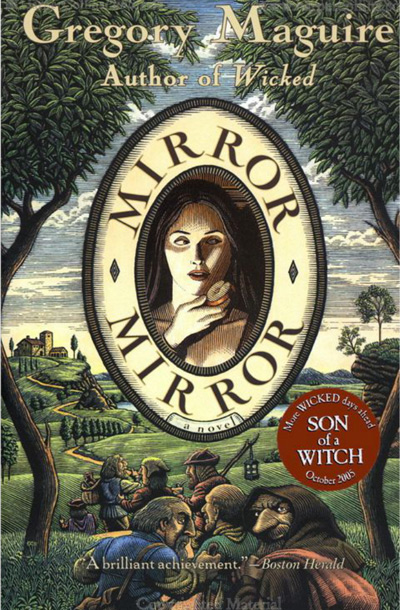8 Novels That Put a Twist On Your Favorite Fairytales
Disney’s latest animated hit, Frozen, offers eye-popping animation, but the plot will be familiar to anyone who knows their fairytales—it’s based on Hans Christian Anderson’s 1845 story The Snow Queen (though there’s no pop culture–savvy snowman in the original…sorry). Putting a new twist on an enduring legend is, of course, nothing new. Here are eight novels that took some liberties in retelling oft-told tales:
Krampus: The Yule Lord, by Brom
In Nordic legend, the Krampus is a familiar holiday figure who watches over children and deems them naughty or nice. Except instead of bringing the nice kids toys, he terrorizes the naughty ones. And instead of appearing with rosy cheeks and a jolly red suit, he wears rusty chains and looks like he stepped out of a Guillermo del Toro movie. When he laughs, he has a stomach that shakes like a bowl full of children’s entrails. And here I thought The Elf on the Shelf was creepy. This (terrifyingly) illustrated version of the story from writer/artist Brom stars a Krampus who is very, very upset about Santa stealing his thunder. Hide yo’ elves, hide yo’ wife.
Beauty and Rose Daughter, by Robin McKinley
Robin McKinley loves the Beauty and the Beast story so much, she rewrote it twice! She launched her career with Beauty, a gentle, fairly straightforward adaptation that is still one of her most beloved novels, and then took another stab at the legend nearly 20 years later with Rose Daughter, which looks at the story through eyes that have seen a bit more of the hardships life can offer. McKinley also reinterpreted Sleeping Beauty in Spindle’s End and adapted the Robin Hood legend into The Outlaws of Sherwood.
Beauty, by Sheri S. Tepper
In Tepper’s twisted, feminist take on Sleeping Beauty, the half-faerie Beauty tricks her twin sister into pricking her finger on that cursed spinning wheel in her stead. That, however, doesn’t protect her from being kidnapped by a band of 21st-century time travelers researching magic in medieval England, nor from the attentions of the Dark Lord (that would be the devil himself), who wants to claim the child in her belly. Perhaps the only version of the story that makes a pit stop in Hell.
Enchantment, by Orson Scott Card
Never one to heed warnings about kissing strange ladies you find sleeping in the woods, the protagonist of Orson Scott Card’s 1999’s novel, based on the Slavic version of Sleeping Beauty, opens with a magical smooch that sends a modern-day Ukrainian-American linguist back in time to 10th-century Russia (what is it with this girl and traveling through time?). Here, the hero and the awakened princess are terrorized by the fearsome witch Baba Yaga, who has her own time travel powers. A richly imagined fantasy, and one the author believes might be his best.
Phoenix and Ashes, by Mercedes Lackey
The standalone fourth installment of Lackey’s fairytale-inspired series The Elemental Masters, Phoenix and Ashes transposes the story of Cinderella to a war-torn version of World War I–era England where magic and wizards exist. Poor orphaned Eleanor, bewitched into servitude by her wicked stepmother, begins to discover her own magical powers, catching the eye of a once-dashing nobleman who was wounded in battle and can no longer perform spells. Traditionalists will be relieved to learn that nasty stepsisters are involved.
Mirror, Mirror, by Gregory Maguire
As these things go, Gregory Maguire is practically a cottage industry at this point, with best-selling reinterpretations of The Wonderful Wizard of Oz (The Wicked Years), Cinderella (Confessions of an Ugly Stepsister), and A Christmas Carol (Lost) to his name. In this skewed version of Snow White, set in Renaissance Italy, the wicked queen is none other than Lucrezia Borgia, daughter of Pope Alexander IV. If you know your history (or even just watched it on TV), you know that a poisoned apple is probably going to be the least of your worries around her.
Sleeping in Flame, by Jonathan Carroll
All of Carroll’s novel seem to exist in a world just this side of a fairytale or a dream, including this sly reinterpretation of the story of Rumpelstiltskin, in which a young writer discovers he is the reincarnated son of the man responsible for the famed myth—and that dear old dad has gotten into the habit of murdering his previous selves. I’d explain more, but it probably won’t make sense. Just read it.
The Robber Bride, by Margaret Atwood
In lesser-known “The Robber Bridegroom,” a young girl betrothed to a rich suitor learns why it’s really important to get to know your betrothed when she pays him an unexpected visit and discovers he’s a murderer. And, um, a cannibal. Atwood’s version flips the genders and updates the setting to Ontario in the 1980s. Oh, also, her villain, Zenia, only devours the men she entraps metaphorically, but she’s still bad news if you ask the women whose guys she stole away.
What’s your favorite reinterpreted fairytale?
